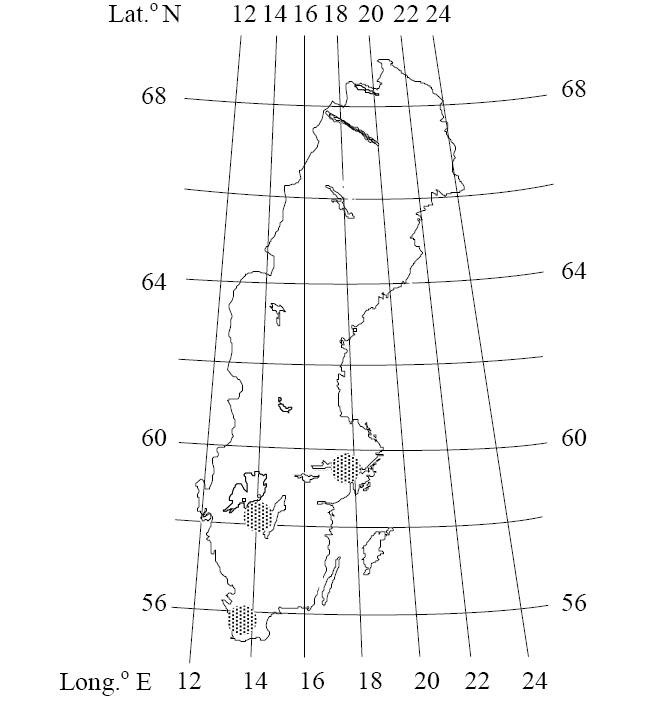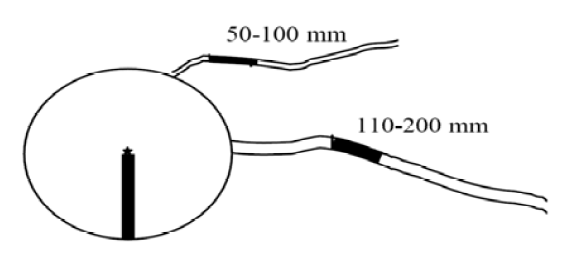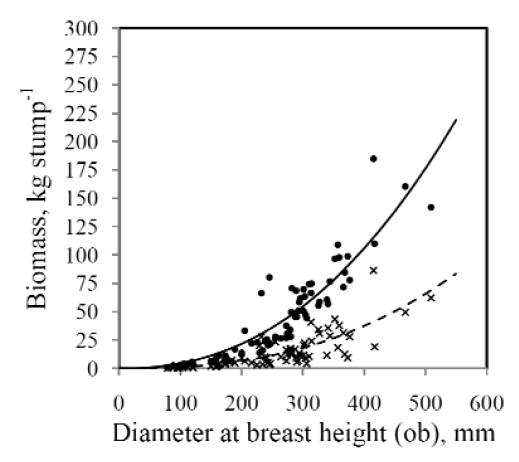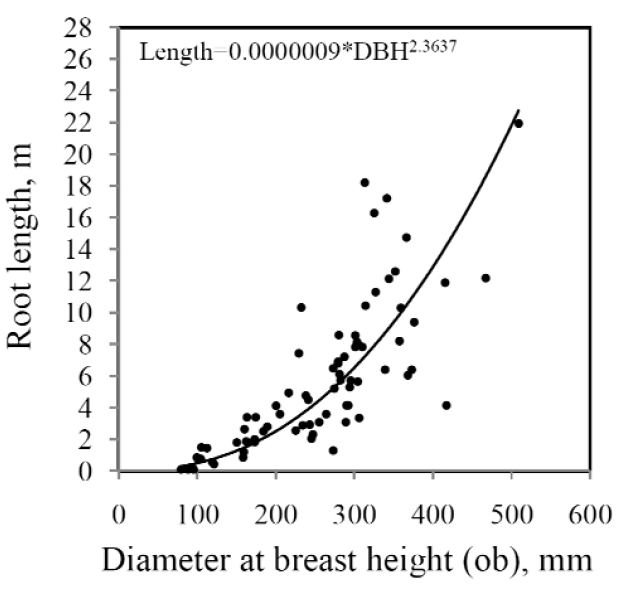Stump and Root Biomass of Poplar Stands
Abstract
:1. Introduction
2. Materials and Methods
2.1. Study Site

| no. | years | Mean ° SD | Mean ° SD | stems ha−1 | m2 ha−1 | Soil type | Variety (1) |
|---|---|---|---|---|---|---|---|
| (1) Clones of poplar species: 1. P. trichocarpa; 2. OP-42 (P. maximowiszii× P. trichocarpa). | |||||||
| 1 | 21 | 353 ° 81 | 29.2 ± 2.0 | 361 | 30.9 | Light clay | – |
| 119–574 | 21.6–32.9 | ||||||
| 2 | 23 | 210 ° 70 | 22.0 ± 3.3 | 632 | 19.1 | Light clay | 1 |
| 81–372 | 12.1–25.8 | ||||||
| 3 | 16 | 140 ° 51 | 21.0 ± 1.3 | 3279 | 42.9 | Light clay | 2 |
| 32–235 | 13.1–22.4 | ||||||
| 4 | 19 | 268 ° 46 | 25.1 ° 1.1 | 1250 | 59.4 | Medium clay | 2 |
| 68–431 | 19.2–27.0 | ||||||
| 5 | 19 | 281 ± 40 | 24.0 ± 0.7 | 675 | 37.8 | Medium clay tills | 2 |
| 194–356 | 22.8–25.0 | ||||||
| 6 | 20 | 283 ° 40 | 25.8 ± 1.1 | 707 | 35.0 | Medium clay | 2 |
| 197–367 | 23.0–27.7 | ||||||
| Mean ± SD | 20 ° 2 | 288 ° 108 | 25.3 ° 4.1 | 1151 ° 1082 | 37.5 ° 13.4 | – | – |
| Range | 16–23 | 81–574 | 12.1–32.9 | 361–3279 | 19.1–59.4 | – | – |
2.2. Characteristics of the Study Stands
2.3. Dry Mass Estimations of Stumps and Roots
| Location no. | Diameter, mm | Height, m | Biomass, above ground, kg d.w. (1) | |
|---|---|---|---|---|
| Breast height | – | Total (2) | Stem | |
| (1) Estimated by Johansson and Karačić [5]; (2) Total: stem + branches + leaves. | ||||
| 1 | 255–509 | 24.4–29.6 | 292–1270 | 177–970 |
| 2 | 119–327 | 15.6–23.2 | 36–428 | 28–326 |
| 3 | 88–216 | 15.3–21.4 | 17–154 | 13–118 |
| 4 | 79–415 | 19.8–27.5 | 13–769 | 10–587 |
| 5 | 232–306 | 23.3–24.7 | 184–363 | 140–277 |
| 6 | 189–376 | 24.7–29.8 | 111–603 | 85–460 |
| Range | 79–344 | 14.6–32.5 | 13–1270 | 10–970 |
| Location no. | Stump diameter, mm | Fresh weight, kg | Dry weight, kg | ||||
|---|---|---|---|---|---|---|---|
| Total | Stump | Roots | Total | Stump | Roots | ||
| 1 | 406 ± 91 | 241 ± 117 | 184 ± 83 | 57 ± 44 | 115 ± 49 | 89 ± 36 | 26 ± 17 |
| 2 | 238 ± 75 | 61 ± 57 | 44 ± 37 | 17 ± 22 | 28 ± 25 | 21 ± 17 | 7 ± 8 |
| 3 | 158 ± 44 | 27 ± 20 | 20 ± 14 | 7 ± 6 | 10 ± 7 | 8 ± 6 | 2 ± 2 |
| 4 | 302 ± 121 | 172 ± 168 | 117 ± 115 | 55 ± 57 | 79 ± 73 | 54 ± 51 | 25 ± 24 |
| 5 | 329 ± 22 | 150 ± 38 | 120 ± 27 | 30 ± 18 | 62 ± 15 | 50 ± 10 | 12 ± 7 |
| 6 | 328 ± 92 | 157 ± 91 | 121 ± 71 | 36 ± 24 | 67 ± 31 | 52 ± 24 | 15 ± 8 |
| Mean ± SD | 294 ± 109 | 133 ± 117 | 99 ± 85 | 34 ± 37 | 59 ± 52 | 45 ± 39 | 14 ± 16 |
| Range | 87–587 | 2–621 | 2–420 | 0.4–201 | 1–291 | 1–185 | 0.2–87 |
| Percentage of total fresh weight | Percentage of total dry weight | ||||||
| Mean ± SD | – | 76 ± 10 | 24 ± 10 | – | 76 ± 11 | 24 ± 11 | |
| Range | – | 43–95 | 5–57 | – | 40–96 | 4–54 |
2.4. Basic Density Analysis

2.5. Soil Analysis
2.6. Data Analyses
3. Results
3.1. Dry Mass Function for Stumps and Roots
| Components | Coefficient | Coefficient estimates | of coefficient | R2 | RMSE | Pr > F |
|---|---|---|---|---|---|---|
| Stump | β0 | 0.000116 | 0.000096 | 0.93 | 15.9123 |
3.2. Biomass Structure of Sample Stumps and Roots

| Location no. | |||||||
|---|---|---|---|---|---|---|---|
| 1 | 2 | 3 | 4 | 5 | 6 | 1–6 | |
| Trees | |||||||
| 0.334 | 0.369 | 0.333 | 0.345 | 0.318 | 0.269 | 0.328 ± 0.033 | |
| Stump | |||||||
| Mean ± SD | 0.323 ± 0.032 | 0.414 ± 0.035 | 0.311 ± 0.009 | 0.325 ± 0.038 | 0.315 ± 0.006 | 0.312 ± 0.006 | 0.333 ± 0.044 |
| Range | 0.28–0.373 | 0.313–0.484 | 0.294–0.324 | 0.262–0.398 | 0.301–0.323 | 0.301–0.318 | 0.262–0.484 |
| Root | |||||||
| Mean ± SD | 0.263 ± 0.030 | 0.364 ± 0.060 | 0.325 ± 0.023 | 0.295 ± 0.026 | 0.314 ± 0.010 | 0.317 ± 0.025 | 0.313 ± 0.044 |
| Range | 0.218–0.307 | 0.265–0.480 | 0.302–0.393 | 0.261–0.340 | 0.303–0.333 | 0.243–0.333 | 0.218–0.480 |

| Location no. % | Root weight, kg d.w. | Root length, cm | ||||||
|---|---|---|---|---|---|---|---|---|
| 50–100 | 101–200 | >200 | Total | 50–100 | 101–200 | >20 cm | Total | |
| 1 | 6.7 ± 2.3 | 14.8 ± 10.9 | 4.2 ± 6.3 | 25.7 ± 17.3 | 587 ± 288 | 221 ± 252 | 105 ± 69 | 913 ± 540 |
| % | 26 | 58 | 16 | – | 64 | 24 | 12 | – |
| 2 | 2.9 ± 1.6 | 4.3 ± 6.6 | 0.3 ± 0.5 | 7.5 ± 8.3 | 225 ± 153 | 128 ± 175 | 20 ± 0 | 373 ± 300 |
| % | 39 | 57 | 4 | – | 60 | 34 | 6 | – |
| 3 | 2.2 ± 1.4 | 0.1 ± 0.3 | 0 ± 0 | 2.3 ± 1.6 | 184 ± 119 | 60 ± 33 | 0 ± 0 | 244 ± 137 |
| % | 96 | 4 | 0 | – | 75 | 25 | 0 | – |
| 4 | 8.8 ± 6.9 | 6.4 ± 6.2 | 9.8 ± 14.5 | 25.2 ± 24.1 | 693 ± 518 | 173 ± 114 | 154 ± 44 | 1020 ± 681 |
| % | 35 | 26 | 39 | – | 68 | 17 | 15 | – |
| 5 | 6.5 ± 1.1 | 3.4 ± 3.8 | 1.7 ± 2.6 | 12.2 ± 7.4 | 451 ± 168 | 104 ± 55 | 75 ± 30 | 630 ± 260 |
| % | 54 | 32 | 14 | – | 71 | 17 | 12 | – |
| 6 | 5.5 ± 2.6 | 7.6 ± 4.4 | 2.3 ± 2.5 | 15.4 ± 8.4 | 417 ± 153 | 167 ± 62 | 70 ± 41 | 653 ± 231 |
| % | 36 | 49 | 15 | – | 64 | 25 | 11 | – |
| Mean ± SD | 5.4 ± 4.1 | 5.9 ± 7.5 | 3.1 ± 7.3 | 14.4 ± 15.6 | 423 ± 319 | 155 ± 153 | 93 ± 57 | 671 ± 468 |
| Range | 0.2–23.7 | 0.0–32.6 | 0.0–51.6 | 0.2–86.5 | 10–1415 | 0–940 | 0–220 | 10–2193 |
| % | 37 | 41 | 22 | – | 63 | 23 | 14 | – |
3.3. Biomass Structure of Stumps and Roots at the Stand Level
4. Discussion
5. Conclusions
Acknowledgements
References
- FAO. Poplars and Willows in Wood Production and Land Use, Food : Rome, Italy, 1980.
- Guzina, V.; Herpka, I.; Marinkovic, P.; Krstinic, A.; Bozic, J.; Vrataric, P. Poplars and Willows in Yugoslavia; 1979; Poplar Research Institute: Novi Sad, Yugoslavia. [Google Scholar]
- Krauter, D.; Lewandowski, I.; Claupein, W. Quantity and quality of harvestable biomass from Populus short rotation coppice for solid fuel use—A review of the physiological basis and management. Biomass Bioenerg. 2003, 24, 411–427. [Google Scholar] [CrossRef]
- Rytter, L.; Johansson, T.; Karacic, A.; Weih, M. Orienterande Studie Om Ett Svenskt Forskningsprogram för Poppel; 2011; Skogforsk: Uppsala, Sweden. [Google Scholar]
- Johansson, T.; Karačić, A. Increment and biomass in hybrid poplar and some practical implications. Biomass Bioenerg. 2011, 35, 1925–1934. [Google Scholar] [CrossRef]
- Verani, S.; Sperandio, G.; Picchio, R.; Spinelli, R.; Picchi, G. Field Handbook-Poplar Harvesting; 2008; Food and Agriculture Organization of the United Nations: Rome, Italy. [Google Scholar]
- Hakkila, P. Utilization of R esidual F uel B iomass ; 1989; Springer-Verlag: Berlin, Germany. [Google Scholar]
- Andersson, E.; Tuimala, A. Definitioner, mm, vid vedundersökningar (Definitions for wood technology); The Nordic Joint Group in Wood Technology Research Note No. 4; 1980; pp. 53–66. Joint Nordic Group for Wood Technology and Producers: Ås, Norway. [Google Scholar]
- Johansson, T. Biomass equations for determining fractions of European pendula and pubescent birches growing on abandoned farmland and some practical implications. Biomass Bioenerg. 1999, 16, 223–238. [Google Scholar] [CrossRef]
- Ekström, G. Klassifikation av svenska åkerjordar (Classification of Swedish soil types on farmland); Serie C. Avhandlingar och Uppsatser, 3448476 ; 1929; pp. 1–161. Geological Survey of Sweden (SGU) (Sveriges Geologiska Undersökning): Stockholm, Sweden. [Google Scholar]
- Kittredge, J. Estimation of the amount of foliage of trees and stands. J. For. 1944, 42, 905–912. [Google Scholar]
- Payandeh, B. Choosing regression models for biomass prediction models. For. Chron. 1981, 57, 229–232. [Google Scholar]
- Satoo, T.; Madgewick, H.A.I. Forest B iomass ; 1982; p. 23. Springer: Berlin, Germany. [Google Scholar]
- Bolstad, P.V.; Gower, S.T. Estimation of leaf area index in fourteen southern Wisconsin forest stands using a portable radiometer. Tree Phys. 1990, 7, 115–124. [Google Scholar]
- SAS, Version 9.1, SAS Institute Inc: Cary, NC, USA, 2006.
- Zar, J.H. Biostatistical A nalysis ; 1999; Prentice Hall: Englewood Cliffs, NJ, USA. [Google Scholar]
- Young, H.; Chase, A.J. Fiber Weight a nd Pulping Characteristics o f t he Logging Residue o f Seven Tree Species i n Maine ; 1965; Maine Agricultural Experiment Station,University of Maine: Orono, ME, USA. [Google Scholar]
- Richardson, J.; Björheden, R.; Hakkila, P.; Lowe, A.T.; Smith, C.T. Bioenergy from S ustainable F orestry : Guiding P rinciples and P ractices ; 2002; Kluwer Academic: Dordrecht, The Netherlands. [Google Scholar]
- Shyam, S.; Srivastava, A.K. Biomass producing potential in age series of Populus deltoides plantation in Rohilkhand Region of Uttar Pradesh. Plant Arch. 2011, 11, 231–237. [Google Scholar]
- Fang, S.; Xue, J.; Tang, L. Biomass production and carbon sequestration potential in poplar plantations with different management patterns. J. Environ. Manag. 2007, 85, 672–679. [Google Scholar] [CrossRef]
- Lodhiyal, L.S.; Singh, R.P.; Rana, B.S. Biomass and productivity in an age series of short rotation Populus deltoides plantations. Trop. Ecol. 1992, 33, 214–222. [Google Scholar]
- Das, D.K.; Chaturvedi, O.P.; Jabeen, N.; Dhyani, S.K. Predictive models for dry weight estimation of above and below ground biomass components of Populus deltoides in India: Development and comparative diagnosis. Biomass Bioenerg. 2011, 35, 1145–1152. [Google Scholar] [CrossRef]
- Puri, S.; Singh, V.; Bhushan, B.; Singh, S. Biomass production and distribution of roots in three stands of Populus deltoides. For. Ecol. Manag. 1994, 65, 135–147. [Google Scholar] [CrossRef]
- Gawith, P.; Douglas, G.; McIvor, I.; Charlton, D. Growing Poplar a nd Willow Trees o n Farms ; 2007; National Poplar and Willow Users Group: Hamilton, New Zealand. [Google Scholar]
- Magagnoti, N.; Nati, C.; Spinelli, R. Harvesting and transport of root biomass from fast-growing poplar plantations. Silva Fenn. 2005, 39, 539–548. [Google Scholar]
- Mattheck, C.; Stokes, A. Variation of wood strength in tree roots. J. Exp. Bot. 1996, 47, 693–699. [Google Scholar] [CrossRef]
- Köstler, J.N.; Brűckner, E.; Bibelriether, H. Die Wurzeln der Waldbäume; 1968; pp. 905–912. Verlag Paul Parey: Berling, Germany. [Google Scholar]
- Faulkner, H.G. Root distribution, amount and development from 5-year-old Populus x euroamericana (Dode) Gunier. M.S. Thesis, University of Toronto, Toronto, ON, Canada, 1976; pp. 231–237.
- Benavides, R.; Douglas, G.B.; McIvor, I.R. Coarse root growth of Veronese poplar trees varies with position on an erodible slope in New Zealand. Agrofor. Syst. 2009, 76, 251–264. [Google Scholar] [CrossRef]
© 2012 by the authors; licensee MDPI, Basel, Switzerland. This article is an open-access article distributed under the terms and conditions of the Creative Commons Attribution license (http://creativecommons.org/licenses/by/3.0/).
Share and Cite
Johansson, T.; Hjelm, B. Stump and Root Biomass of Poplar Stands. Forests 2012, 3, 166-178. https://doi.org/10.3390/f3020166
Johansson T, Hjelm B. Stump and Root Biomass of Poplar Stands. Forests. 2012; 3(2):166-178. https://doi.org/10.3390/f3020166
Chicago/Turabian StyleJohansson, Tord, and Birger Hjelm. 2012. "Stump and Root Biomass of Poplar Stands" Forests 3, no. 2: 166-178. https://doi.org/10.3390/f3020166
APA StyleJohansson, T., & Hjelm, B. (2012). Stump and Root Biomass of Poplar Stands. Forests, 3(2), 166-178. https://doi.org/10.3390/f3020166




